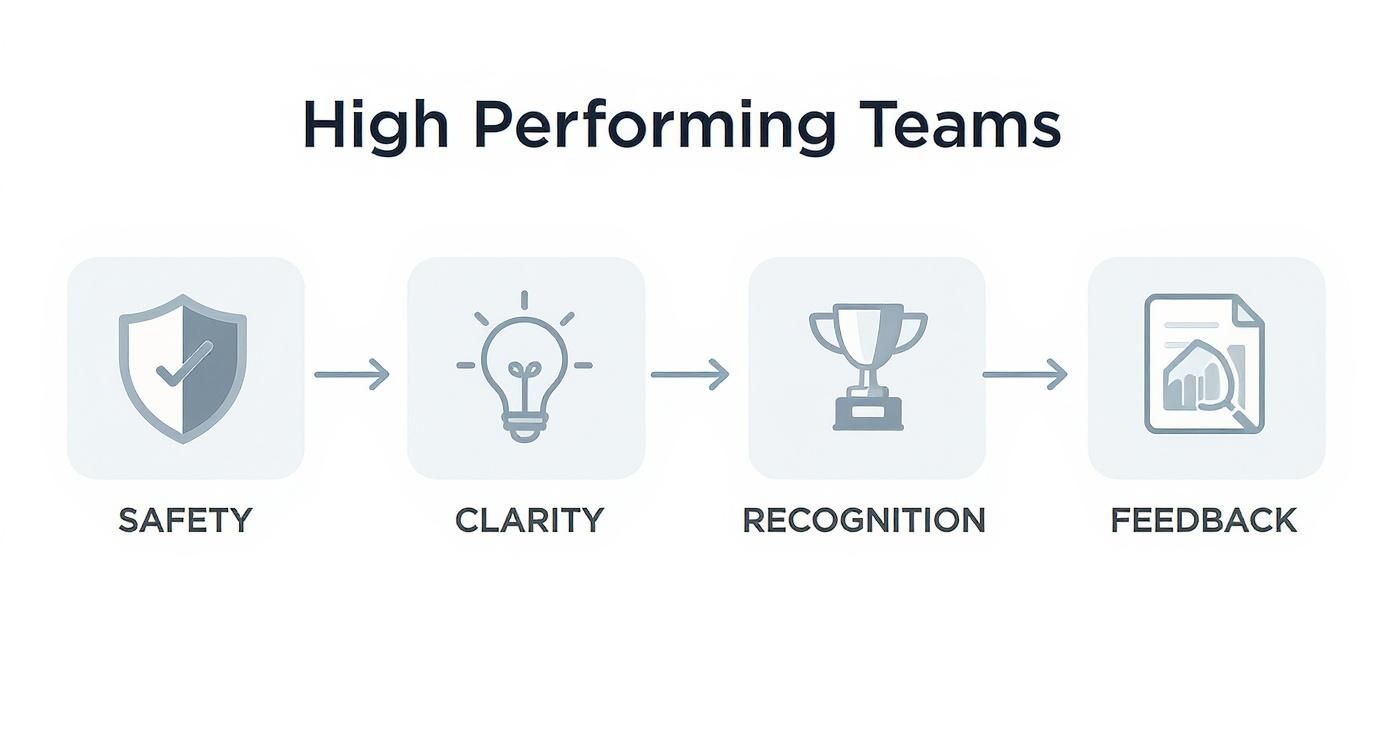Building a high-performing team really comes down to four things: creating psychological safety, establishing radical role clarity, embedding meaningful team recognition, and using data-driven feedback. This isn't about slapping motivational posters on the wall; it's a deliberate, systematic process for creating an environment where talented people can truly do their best work.
Table of Contents
The Blueprint for High Performing Teams
Let's cut right to it. Elite teams don't just happen by accident—they are intentionally built. They operate on a foundation that encourages smart risk-taking, demands clear ownership, and is obsessed with getting better every single day. Forget the idea of luck or just hiring a bus full of "A-players." Sustained success is a direct result of the environment you architect.
The framework I use is straightforward and focuses on four non-negotiable pillars. Think of them as addressing fundamental human needs at work: the need to feel safe, to know what's expected, to feel valued, and to see a path for growth. If you let even one of these pillars crumble, the whole structure becomes unstable, leading to confusion, disengagement, and eventually, burnout.
The Four Foundational Pillars
These four elements don't work in isolation; they create a reinforcing system where the whole is far greater than the sum of its parts.
-
Psychological Safety: This is the bedrock. It’s the shared belief that you can speak up, ask a "dumb" question, or admit a mistake without being embarrassed or punished. When people feel safe, they innovate. They solve problems. They take ownership.
-
Radical Role Clarity: Ambiguity is the silent killer of performance. Every single person on the team needs to know exactly what they're responsible for, what a "win" looks like for their role, and how their daily work connects to the bigger picture. No gray areas.
-
Meaningful Recognition: Great work can't happen in a vacuum. Recognizing and celebrating contributions—both big and small—is how you reinforce the behaviors you want to see more of. It's not just a "nice-to-have"; recognition is a powerful motivator that makes people feel seen, valued, and connected to the mission, which is the fuel for sustained high performance.
-
Data-Driven Feedback: The best teams are never satisfied with the status quo. They use objective data and structured feedback loops to have honest, productive conversations about what's working and what's not. It’s about improvement, not blame.
This process isn't just a random list; it's a sequence. Each element builds on the last, creating a powerful cycle of performance.

As you can see, psychological safety isn't just a nice-to-have; it's the launchpad. Without it, none of the other high-performance traits can truly take root.
The importance of this first pillar is backed by serious data. Google's famous two-year study, Project Aristotle, found that psychological safety was the single most important dynamic in successful teams, explaining 43% of the variance in performance.
The results speak for themselves. Teams with high psychological safety were 19% more productive, 31% more innovative, and had 27% lower employee turnover rates. These principles become even more critical in a remote setting, where clear communication and trust are paramount. Diving into the best practices for remote teams can give you more specific tactics for distributed environments.
This isn't just theory. It's a practical playbook for building a team that doesn't just meet expectations, but consistently blows them out of the water.
Core Pillars of High Performing Teams
To put it all together, here’s a quick summary of these essential components. Think of this as your cheat sheet for building an elite team.
| Pillar | Why It Matters | Your First Action |
|---|---|---|
| Psychological Safety | It unlocks candor, innovation, and learning by removing the fear of failure. | In your next team meeting, openly share a mistake you made and what you learned from it. |
| Radical Role Clarity | It eliminates confusion and empowers individuals by defining ownership and success. | Create a simple "Role Scorecard" for one team member, outlining their top 3 accountabilities and key metrics. |
| Meaningful Recognition | It reinforces desired behaviors and makes people feel seen, valued, and motivated. | Set a goal to give specific, timely praise to one person on your team every single day for a week. |
| Data-Driven Feedback | It fuels continuous improvement by focusing on objective results, not opinions. | Identify one key team metric (e.g., response time, sales) and start tracking it visibly for the team. |
By focusing on these four areas, you shift from managing a group of individuals to leading a cohesive, high-impact team.
Create Psychological Safety to Unlock Performance
Let's talk about the invisible architecture of every great team: psychological safety. It’s that shared feeling in the room that you can speak up—with ideas, questions, concerns, or even mistakes—without fear of being shut down or humiliated. When you get this right, innovation, vulnerability, and honest feedback aren't just possible; they become the team's default setting.
Think of it like a high-wire act. Without a net, the performers play it safe, sticking to simple, predictable moves. But with a net? They feel secure enough to attempt breathtaking feats, pushing the boundaries of what's possible. Your team is no different. Without psychological safety, they’ll stick to the well-trodden path, avoiding the very risks that lead to breakthroughs.
This isn’t just a feel-good concept; it has a real, measurable impact on the bottom line. Teams where people feel safe are far more likely to admit errors, ask for help, and challenge the status quo. This climate of openness is what fuels learning and stops small problems from spiraling into massive failures.

Model Vulnerability from the Top
The journey toward psychological safety always starts with leadership. Your actions as a leader send a much stronger signal than any company policy ever could. When you openly admit your own mistakes or say "I don't know," you give your team permission to be human, too.
For instance, instead of glossing over a miscalculation, try saying this in a team meeting: "I completely misjudged the timeline for the Q3 project, and that's on me. Here’s what I learned from it, and here’s how I think we should adjust our process." A single statement like that reframes failure as a learning opportunity and builds trust faster than any offsite ever will.
Vulnerability isn't a sign of weakness. It's a display of strength and self-awareness that tells everyone that perfection isn't expected, but honesty and growth are non-negotiable.
Reframe Failure as Data
One of the most profound shifts you can make is to change how your team talks about failure. In a blame culture, a missed deadline is a hunt for a culprit. In a high-performance culture, it’s just a new data point.
I once saw a marketing team launch a campaign that completely whiffed on its lead generation target. The initial reaction was a flurry of finger-pointing. The manager skillfully intervened, reframing the conversation with a simple question: "What did we learn? What assumptions were wrong, and what does this data tell us about our audience?"
That one question transformed a moment of failure into a productive debrief. The team uncovered a critical flaw in their customer persona and used that insight to launch a wildly successful campaign the next quarter. They learned to celebrate the intelligent risk and the learning it produced, not just the win.
Key Takeaway: You have to make it safer for your team to flag a problem than to stay silent. When mistakes become opportunities for the whole team to learn, people become willing to take the smart risks that drive innovation.
Actively Solicit Different Perspectives
Silence in a meeting is often mistaken for agreement. More often than not, it’s a sign of fear. The best teams don't just allow dissent; they actively go looking for it. This means you have to intentionally make space for the quieter voices in the room.
Try baking these powerful, open-ended questions into your team meetings:
- "What are we missing here?"
- "I'd love to hear a completely different take on this."
- "What's a potential risk with this approach that no one has mentioned yet?"
- "Play devil's advocate for a moment—what would have to be true for this entire project to fail?"
These questions aren't just conversation starters; they are explicit invitations for constructive disagreement. They signal that you value thoughtful challenges over blind consensus. I’ve found that publicly thanking people who offer dissenting views is critical to reinforcing this behavior. Building this habit is a cornerstone of strong team dynamics, and you can explore more strategies on how to improve team communication to make it stick.
By making it a team norm to question assumptions, you build resilience and a knack for spotting flaws before they become catastrophes. The goal is simple: create a culture where the best idea wins, no matter who or where it came from.
Establish Radical Clarity in Roles and Goals
Now that your team has a foundation of psychological safety, the next real performance booster is radical clarity. I can't stress this enough: ambiguity is the enemy of execution.
When people aren't sure what their exact role is, what a "win" looks like, or how their day-to-day work actually matters to the bigger picture, you get chaos. They waste precious time and energy on duplicate tasks, turf wars, and internal politics instead of just getting things done.
High-performing teams are built by stamping out that confusion. Every single person needs to understand their specific responsibilities and the exact outcomes they're accountable for. This isn't about micromanaging; it's about empowering them. Clarity gives people the confidence and autonomy to make smart decisions on their own, quickly and effectively.

Go Beyond Basic Job Descriptions
Let's be honest, standard job descriptions are often too generic to be of any real use once the work starts. For genuine clarity, you need a living document that goes beyond a list of tasks and outlines decision-making power and how people should work together. This is where a Roles and Responsibilities Charter becomes invaluable.
Think of this charter as your team's internal constitution. It clearly defines:
- Core Responsibilities: The top 3-5 outcomes each person is accountable for.
- Decision Rights: Who gets the final say on specific decisions (e.g., budget, hiring, technical approach)?
- Interaction Protocols: The ground rules for how the team collaborates and communicates on shared projects.
- Key Metrics: How success in that role is actually measured.
For instance, a charter for a Product Manager might state they have the final call on the feature backlog but must consult engineering on feasibility. That one simple rule can prevent countless hours of debate and keep the workflow smooth.
Define Success with Clear Frameworks
Once roles are crystal clear, you have to get everyone aligned on what you're collectively trying to achieve. Fuzzy goals like "improve customer satisfaction" are useless because no one knows how to act on them. To get everyone on the same page, you need a solid framework. A great starting point is setting SMART goals, which ensures your objectives are Specific, Measurable, Achievable, Relevant, and Time-bound.
Another incredibly effective system is Objectives and Key Results (OKRs). I love this framework because it directly connects ambitious company-wide goals to the measurable work of individual teams.
Key Takeaway: OKRs separate your destination (the Objective) from your directions (the Key Results). The Objective is qualitative and inspirational, while the Key Results are the hard numbers that prove you got there.
Let’s look at a real-world example. Imagine a software development team is tasked with reducing customer churn. Here’s how they could structure their OKRs for the next quarter:
- Objective: Delight our existing users to dramatically improve customer loyalty.
- Key Result 1: Reduce monthly user churn from 4% to 2.5%.
- Key Result 2: Increase the adoption rate of our new "Project Dashboard" feature from 15% to 40%.
- Key Result 3: Decrease the average support ticket response time from 8 hours to 3 hours.
This structure leaves zero room for misinterpretation. The team knows exactly what success looks like and can focus their daily work on moving these specific numbers.
Map Your Workflows to Spot Bottlenecks
Finally, clarity isn't just about roles and goals; it's also about the actual processes your team uses day-in and day-out. A powerful exercise I recommend is to visually map your core workflows, from the first idea all the way to delivery. This helps everyone see how the pieces fit together and quickly exposes hidden points of friction.
Grab a whiteboard or open a digital tool and chart out the steps for a key process, like deploying a new software feature. As you map it out with the team, ask some tough questions:
- Where do handoffs happen between people?
- Which stages seem to cause the most delays?
- Are there unnecessary approval steps slowing us down?
This visual map makes bottlenecks impossible to ignore. You might suddenly realize that all design approvals have to go through a single person, creating a constant roadblock. Once you see it, you can fix it—maybe by empowering senior designers to approve certain changes themselves. When everyone can see the whole system, they can work together to make it better, ensuring the entire team is pulling in the same direction with purpose.
Weave Rituals into Your Team's DNA
Great teams aren't built on grand, one-off gestures. They're forged in the small, consistent, positive interactions that happen every single day. The real secret is designing and committing to team rituals—repeatable, intentional actions that build deep connections and embed recognition right into your team's culture. These rituals become the operating system for high performance, turning the behaviors you want to see into second nature.
Think of it like this: you can't get in shape with a single workout, but a consistent routine changes everything. In the same way, a one-time "thank you" is nice, but a daily habit of celebrating wins is what builds a resilient, motivated team. By creating predictable moments for connection and praise, you remove the friction, making it an effortless part of everyone's workflow.
These aren't just more meetings on the calendar; they are the moments that come to define your team's identity. They signal what you truly value and create a shared rhythm that keeps everyone in sync, which is especially critical when people are working from different locations and miss out on those spontaneous office chats.
Make Recognition a Daily Habit
The most powerful recognition is the kind that happens in the moment. If you wait for a quarterly review to acknowledge amazing work, the impact is lost. It’s like waiting until the end of a marathon to offer a drink of water. To build a truly high-performing team, recognition needs to be a daily, peer-driven habit.
Imagine a team where celebrating each other's wins is a natural reflex. It’s not a fantasy; it’s entirely achievable with the right rituals.
-
Create a Dedicated 'Kudos' Channel: This is a simple but powerful one. Set up a channel in Slack or Microsoft Teams called something like
#kudos,#wins, or#props. This gives everyone a central, public place to shine a spotlight on a teammate’s hard work, helpfulness, or a big win. For example, a simple message like, "Huge props to @Sarah for staying late to help me fix that critical bug before the demo. You saved the day!" is incredibly motivating. Leaders must model this behavior consistently to get the ball rolling. -
Kick Off Meetings with Shout-Outs: Carve out the first five minutes of a weekly sync or Monday kickoff for peer-to-peer recognition. Just go around the virtual room and ask, "Who wants to give a shout-out to someone who helped them out this week?" This simple act immediately sets a positive tone and reinforces a culture of looking out for one another.
A strong peer recognition system does more than just boost morale. It gives leaders priceless data on who the key connectors and collaborators really are. For those looking to take this a step further, exploring different recognition and rewards programs can help you build a more structured approach that scales.
Key Takeaway: Recognition is a behavior multiplier. What gets recognized gets repeated. By consistently and publicly celebrating specific actions, you are clearly showing the entire team, "This is what success looks like here."
The Hard Numbers Behind Acknowledgment
This focus on frequent praise isn’t just a feel-good initiative; it’s a strategic move with a direct line to business outcomes. Gallup's extensive research on team dynamics drives this point home. Their meta-analysis of over 183,000 teams found a powerful connection between engagement and performance.
Teams in the top quartile for engagement were 18% more productive in sales and 14% more productive in production compared to their counterparts in the bottom quartile. Even better, these highly engaged teams were 23% more profitable. The proof is in the numbers: a culture of appreciation directly impacts the bottom line. You can discover more insights from Gallup's research on high-performing teams to see the full picture.
Ditch the Status Updates in Your Retrospectives
Weekly retrospectives should be a sacred ritual, but too often they devolve into complaint sessions or dry status updates. An effective retrospective is a ritual for learning, not just reporting. The whole point is to uncover genuine insights that will make the team stronger, faster, and more connected for the next sprint.
To get past the generic "what went well, what didn't" format, you need to structure your retros with more thoughtful prompts.
Better Questions for Better Retrospectives:
| Prompt Category | Specific Question to Ask | What It Uncovers |
|---|---|---|
| Energy & Morale | "What moment this past week gave you the most energy?" | Highlights what truly motivates and engages your team members. |
| Process & Flow | "Where did you feel like you were swimming upstream against our process?" | Pinpoints specific points of friction and workflow bottlenecks. |
| Collaboration | "Who on the team do you want to thank for helping you overcome a hurdle?" | Combines gratitude with a look at what makes teamwork click. |
| Future-Focused | "What's one small experiment we could try next week to improve?" | Shifts the focus from dwelling on the past to actively shaping the future. |
When you ask better questions, you get a more meaningful conversation. This transforms the retro from a meeting people dread into a high-value session for problem-solving and team-building. These intentional rituals are the engine of continuous improvement, reinforcing the psychological safety and role clarity a team needs to not just perform, but truly thrive.
Measure What Matters for Continuous Improvement
If you can’t measure it, you can’t improve it. That’s an old saying, but it’s the bedrock of any high-performing team. To get beyond just feeling like things are going well, you need a modern, data-informed way to track both team health and performance.
This isn't about micromanaging or creating a culture of surveillance. It’s about giving your team the information they need to see their own progress, identify friction points, and get better every single week.
The trick is to focus on what actually moves the needle. Too many leaders get bogged down tracking output metrics—things like features shipped or tickets closed. While those numbers have their place, they don't paint the full picture. The truly great teams are obsessed with outcome metrics: the real-world value their work creates.
Distinguish Outputs from Outcomes
Getting clear on the difference between outputs and outcomes is a game-changer. Outputs are the stuff you produce. Outcomes are the results you deliver. One is about being busy, the other is about being effective.
Let's look at a customer support team.
| Metric Type | Example | What It Really Tells You |
|---|---|---|
| Output Metric | Answered 1,000 support tickets this week. | The team was definitely busy and handled a high volume of work. |
| Outcome Metric | Customer Satisfaction (CSAT) score increased by 15%. | The team's work is actually making customers happier. |
| Outcome Metric | Reduced average time-to-resolution by 20%. | The team is solving problems faster, giving customers back their time. |
See the difference? A team laser-focused on the output of "1,000 tickets" might be tempted to rush through them, letting quality slip. But a team aiming for better outcomes will naturally find ways to improve their process, leading to happier customers and efficient work.
Build Continuous Feedback Loops
Let's be honest: the annual performance review is dead. High-performance cultures thrive on a constant flow of feedback that’s timely, frequent, and comes from all directions. You have to build simple, low-effort ways for that feedback to happen naturally.
You don't need a complicated system to get started. Try these:
- Lightweight Weekly Check-Ins: Set up an automated poll in Slack that fires off every Friday afternoon. Ask two simple questions: "On a scale of 1-5, how was your week?" and "What's one thing that could make next week even better?" This gives you an immediate pulse on team morale and helps you catch small frustrations before they become big problems.
- Simple 360-Degree Reviews: Ditch the heavy annual process for a quick, quarterly version. Ask team members to share feedback for their peers using two powerful prompts: "What is one thing [Teammate's Name] should continue doing?" and "What is one thing they could start doing to have an even bigger impact?"
These simple loops arm you with the data you need for more meaningful one-on-ones, shifting them from critiques to collaborative coaching sessions that are all about growth.
A focus on team health and connectivity isn't just a "nice-to-have"—it directly fuels the bottom line. Research shows that connected teams achieve a 21% increase in profitability. This connection also builds resilience, as these teams see 41% less absenteeism and 59% lower turnover. You can discover more about how team health impacts key business metrics.
Create Your Team Health Dashboard
The final step is to pull all these streams of information into a single team health dashboard. Think of it as your command center, giving you an at-a-glance view that balances productivity with people. The goal is to track a few key indicators across different areas to get a holistic view.
A well-rounded dashboard might include:
- Performance Metrics: Your top 1-2 outcome metrics (e.g., customer adoption rate, user retention).
- Well-being Metrics: The weekly morale score from your automated check-ins.
- Collaboration Metrics: Peer recognition data from a tool like AsanteBot can surface who the key connectors and collaborators are on your team.
- Growth Metrics: Simple tracking of progress on individual development goals.
With this balanced approach, you stop pushing for more output at the cost of burnout. Instead, you're building a sustainable system where a healthy, engaged, and connected team naturally delivers incredible results.
Your Questions Answered: Practical Advice for Building Great Teams
It's one thing to read about the theory of building great teams, but it’s another thing entirely to apply it when you're in the trenches. The real world is messy. Here are some answers to the most common questions leaders ask me when they're navigating the day-to-day challenges of team building.
How Do I Fix a Struggling Team?
When a team is underperforming, it’s tempting to jump in with a quick fix. Don't. Your first job is to play detective, not hero.
Start by digging into the root cause with confidential one-on-one chats. You need to understand the real problem before you can solve it. Is the team unclear on their goals? Are they burnt out? Is there a simmering conflict between two members that's poisoning the well?
Once you have a better handle on the situation, your top priority is to rebuild psychological safety. I’ve seen this work wonders: facilitate a "team reset" meeting. This is a dedicated session where everyone gets to voice their concerns and, more importantly, agree on new ground rules for how they’ll communicate and work together. It’s a clean slate.
Right after that reset, you have to give them a win. Work together to set a single, super clear, and achievable short-term goal. Nailing a tangible objective, no matter how small, is a powerful way to rebuild momentum and confidence. Remember, struggling teams are almost always dealing with a combination of low trust and fuzzy direction—you have to tackle both head-on to get back on track.
What’s the Single Most Important Habit a Leader Can Have?
Consistency. It’s that simple.
A high-performing team isn't born from a one-off workshop or an inspiring speech. It's forged in the thousands of tiny, consistent interactions you have every single day. The most powerful habit you can build is to consistently model the exact behaviors you want to see in your team—especially when it comes to vulnerability and accountability.
This means you’re the first to say, "I messed that up." It means you listen more than you talk in meetings. And it means you are absolutely relentless in calling out and celebrating the great work of others. For example, when you see a junior developer solve a tricky problem, don’t just move on. Drop a message in the team channel: "Amazing work, @James, on figuring out that API issue. That was a tough one, and your persistence saved us a lot of time." Your team is watching your actions far more closely than they're listening to your words.
When your team sees you consistently living the values of psychological safety and meaningful recognition, they will follow suit. Inconsistency, on the other hand, erodes trust faster than almost anything else.
Can You Really Build a High-Performing Team in a Fully Remote Setup?
Absolutely, but it takes a much more deliberate and intentional approach. You can't just hope for connection and clarity to happen organically like they might in an office. In a remote or hybrid world, you have to consciously design and build those moments.
This means getting proactive about how your team communicates and connects.
- Make time for "non-work" talk. Schedule virtual coffee chats or team lunches with no agenda. This is where the real rapport and trust are built.
- Over-communicate in writing. Goals, priorities, and key decisions need to be documented and shared where everyone can see them, regardless of their time zone.
- Set clear communication protocols. Define when to use Slack, when to send an email, and when something needs a video call. It removes so much guesswork.
- Use tools for public recognition. In a remote environment, contributions can easily become invisible. Make praise visible and frequent to ensure people feel seen and valued. For example, a shared "wins" document or a dedicated Slack channel where people post successes is crucial. This visibility is vital because it combats the "out of sight, out of mind" problem and reinforces that every contribution matters.
The best remote teams I've worked with are masters of documentation and disciplined communication. That’s not a coincidence; it's a requirement for success when you're distributed. Your job as a leader is to be intentional about fostering human connection, even through a screen. Do that, and you can build a team that's not just high-performing but also deeply connected, no matter where they log in from.
Ready to make recognition a seamless and powerful ritual for your team? AsanteBot integrates directly into Slack to make celebrating wins a daily habit. With customizable rewards, insightful analytics, and automated milestone celebrations, you can build the positive culture that fuels high performance. See how easy it is to get started with AsanteBot.




